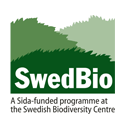Scientific Classification
Species in the Genus
Species in Kenya, Tanzania & Uganda
Description
Possible Causes of Confusion
Distribution in Kenya, Tanzania & Uganda
Habitats
Nesting
Crops Visited
Other Plants Visited
Economic / Ecological Importance
Threats
Conservation and Management Practices
Legislation (National and International)
References
Editors
Acknowledgements
Contact
Click on images to enlarge
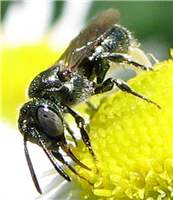
Ceratina calcarata. Photo by J.C. Lucier (CC BY-NC 2.0)

Ceratina species. Photo by Ferran Turmo Gort (CC BY-NC-SA)
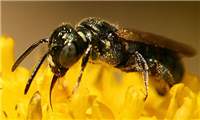
Ceratina species. Photo by Seabrooke Leckie (CC BY-NC-ND)

Ceratina strenua. Photo by J.C. Lucier (CC BY-NC 2.0)
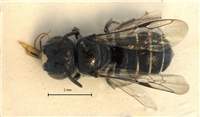
Ceratina moerenhouti (female) - pinned specimen. Photo: Connal Eardley
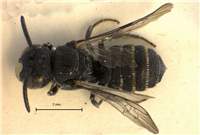
Ceratina moerenhouti (male) - pinned specimen. Photo: Connal Eardley
Summary
Honey bees are not the only bee species that are significant for human wellbeing. Ceratina bees are a group of native bee species that do not produce honey but are important pollinators of crops and wild plants. Ceratina bees are not aggressive but can sting for defence. Ceratina bees are usually dark with a shiny or metallic appearance, sparse-haired and medium-sized. Most species of Ceratina bees live independently of others (i.e. they are solitary) but some species live in small colonies and a few appear to have nests with several adult females. They usually nest in woody materials in various locations mostly in shaded environments. This fact sheet provides information about these bees to encourage farmers to understand and protect them to help ensure that their crops are effectively pollinated.
From a conservation and agricultural standpoint it is not necessary to recognise all the different bee genera. However, it is important to know that there is a large bee biodiversity. Different bee genera pollinate different plant species, although there is some overlap that acts as a buffer as bee populations wax and wane. For healthy ecosystems, including agro-ecosystems both diversity and abundance in the bee fauna is important.
Common Name (Language)
Small carpenter bee (English) – they share this common name with bees of the tribe Allodapini.
Scientific Classification
Kingdom: Animalia
Phylum: Arthropoda
Class: Insecta
Order: Hymenoptera
Family: Apidae
Subfamily: Xylocopinae
Tribe: Ceratini
Genus: Ceratina Latreille, 1802
Species in the Genus
Ceratina is a genus that comprises of about 350 species distributed throughout the world. Ceratina bees (small carpenter bees) are closely related to the more familiar (“large�?) carpenter bees (Xylocopa species).
Species in Kenya, Tanzania & Uganda
More than 20 species have been recorded in different habitats in
Description
Ceratina bees are not well known by local people (including farmers) in
Possible Causes of Confusion
Some insect species can be confused with the larger Ceratina bees: These include species that are frequently seen on flowering plants during peak blooming periods such as leafcutter and dauber bees ( Megachile bees), halictine bees and small beetles (Coleoptera species). Female Ceratina bees can be distinguished from Megachile bees by the fact that they carry pollen on the hind legs whereas Megachile bees carry pollen under the abdomen . Ceratina bees can be distinguished from halictine bees by their mouthparts (Ceratina bees have a long glossa – “tongue�?) and their hind wings (which have a tiny jugal lobe – posterior area of wing). Beetles have hardened fore-wings (elytra ) while bees have four membranous wings. Smaller Ceratina bees can be confused with Allodapula bees (also sometimes known as small carpenter bees). Ceratina bees are mostly well sclerotised (“armoured�?) and robust, and they are mostly black or metallic blue. Allodapula bees are weakly sclerotised and fragile looking.
Distribution in Kenya, Tanzania & Uganda
Ceratina bees are found in most districts/regions of
Habitats
Ceratina bees can be found in various habitats (land-uses) in East Africa such as grasslands, natural forests, wetlands, marshlands, open habitats, protected areas, farmlands, rangelands, woodlands, woodlots (forest plantations), riparian areas.
Nesting
Most Ceratina bee species are solitary bees that make nests in dead wood, stems, or pith. However, a number are subsocial, with mothers caring for their larvae, and in a few cases where multiple females are found in a single nest, daughters or sisters may form very small, weakly eusocial colonies (where one bee forages and the other remains in the nest and lays eggs). Most species occurring in East Africa nest in self-made tunnels in woody materials on the ground, in the soil and in walls of abandoned houses or in the soil.
Crops Visited
Most Ceratina bee species in East Africa collect nectar and pollen from various flowering crop species belonging to different plant families (are polylectic) while a few visit a narrower range of plants (are oligolectic). These bees are efficient pollinators of crops such as beans, cowpeas, simsim (sesame), apples and coffee.
Other Plants Visited
In
Economic / Ecological Importance
Little information exists on the usefulness of these bees to the lives of the people in
Threats
In
Conservation and Management Practices
There are now concerted research efforts in the region to develop best practices for conservation and management of bees to enhance crop production. Theoretically, bee conservation and management is inexpensive and adopted activities can also improve the aesthetic value of the landscape. Such practices involve setting land aside (e.g. a 1-metre strip) in the farmland to host all year round food resources for the bees, as well as safer sites for nesting, mating, resting and hiding from natural enemies. During flowering, farmers should manage pesticide usage carefully to avoid poisoning flower-visiting bees. Farmers should also minimise pesticide drift from the field to adjacent areas. Wood collection should be managed to conserve nesting sites wood-nesting species and trampling by people and livestock and tilling should be managed to conserve the nesting sites of soil-nesting species. KARI (the Kenya Agricultural Research Institute) is developing protocols for mass rearing of different species of solitary bees. Any successful results from this research will be freely communicated to the public. In addition, KARI is collaborating with other stakeholders to ensure in situ conservation and management of bees for pollination purposes. Much of the work of conserving native bees will be underpinned by raising public awareness of the importance of these species.
Legislation (National and International)
There is not yet any legislation in
References
1. Eardley CD and Daly HV (2007) Bees of the genus Ceratina Latreille in southern
2. Eardley CD, Gikungu MW and Schwarz MP (2009) Bee conservation in Sub-Saharan Africa and
3. Eardley CD, Kuhlmann M and Pauly A. (2010) The Bee Genera and Subgenera of sub-Saharan
4. Eardley CD and Urban R (2010) Catalogue of Afrotropical bees (Hymenoptera: Apoidea: Apiformes). Zootaxa, 2455: 1–548.
5. Michener CD (2007) The Bees of the world, the John Hopkins University Press,
Editors
Théodore Munyuli, Busitema University - Uganda; Muo Kasina, Kenya Agricultural Research Institute (KARI) - Kenya; Juma Lossini, Tropical Pesticides Research Institute (TPRI) – Tanzania; John Mauremootoo, BioNET-INTERNATIONAL Secretariat – UK; Connal Eardley, Plant Protection Research Institute (PPRI) – South Africa.
Acknowledgements
We recognise the support from the Kenya Agricultural Research Institute (KARI), Tropical Pesticide Research Institute (TPRI) –
Contact
BioNET-EAFRINET regional coordinator: [email protected]





